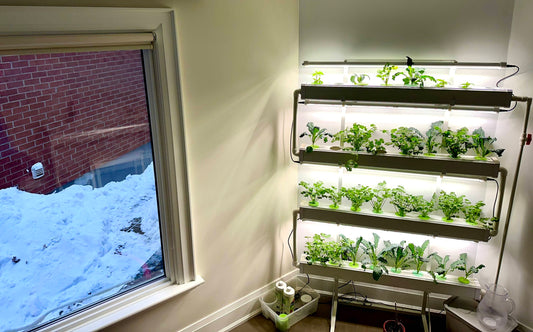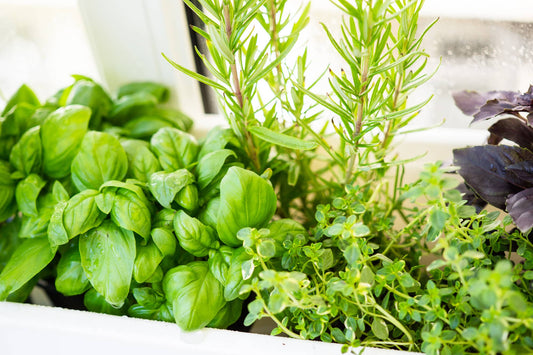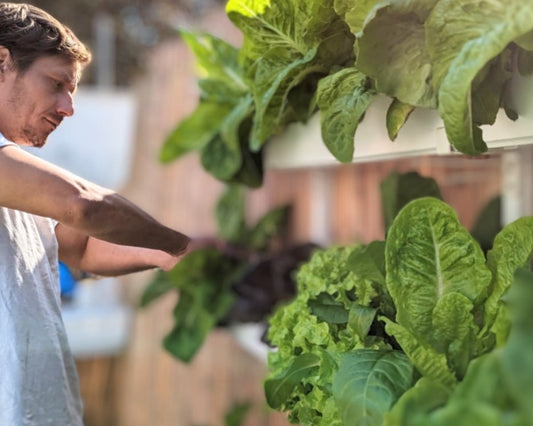Introduction
Hydroponic gardening is an efficient and controlled way to grow plants at home, but success depends on maintaining the right conditions. While some factors are unique to hydroponic systems, others are essential for all plant growth, whether in soil or hydroponics. This guide will cover the essential hydroponic-specific water conditions first, followed by the general plant needs that apply to all growing methods.
Essential Water Conditions for Hydroponics
The main difference between hydroponics and soil-based growing is that nutrients are delivered entirely through water. For a thriving hydroponic system, growers must maintain four key water conditions: nutrients, pH balance, oxygenation, and temperature.
1. Nutrients in Hydroponic Water
In hydroponics, synthetic fertilizers are commonly used because they provide an already balanced nutrient formula that meets the needs of most plants. These fertilizers contain a specific ratio of essential nutrients, ensuring plants receive everything they need for growth without the need for soil-based nutrient breakdown.
-
Macronutrients (provided in larger quantities):
- Nitrogen (N) – Promotes leaf and stem growth.
- Phosphorus (P) – Essential for root development and flowering.
- Potassium (K) – Supports overall plant health and disease resistance.
- Calcium (Ca) – Strengthens cell walls and prevents disorders like blossom end rot.
- Magnesium (Mg) – A key component of chlorophyll, necessary for photosynthesis.
- Sulfur (S) – Supports enzyme function and protein synthesis.
-
Micronutrients (provided in smaller amounts but still essential):
- Iron (Fe) – Vital for chlorophyll production.
- Manganese (Mn) – Helps with nitrogen metabolism.
- Zinc (Zn) – Important for hormone production and growth.
- Copper (Cu) – Aids in plant metabolism.
- Molybdenum (Mo) – Supports nitrogen absorption.
- Boron (B) – Assists in cell wall formation and fruit development.
While different plants have unique nutrient needs, most plants can thrive with the average nutrient formula found in synthetic fertilizers. This means growers do not need to stress about tailoring nutrients for each individual plant—using a standard balanced solution will work well for nearly all hydroponic crops.
Nutrient levels are measured using EC (Electrical Conductivity) or PPM (Parts Per Million) meters.
- EC (preferred at NatureTech Hydroponics) is a more consistent measurement of nutrient concentration. EC measures how well the water conducts electricity, which correlates directly with the concentration of dissolved salts (nutrients) in the water. A higher EC value means a higher concentration of nutrients, while a lower EC value means fewer nutrients are available.
- PPM is also an acceptable method, though it has more variability due to different conversion scales. PPM measures the total dissolved solids (TDS) in water, representing the nutrient concentration in terms of parts per million. However, different TDS meters use different conversion factors, making EC a more universally reliable measurement.
Plants prefer precise nutrient levels, but they are also resilient. They do not require daily adjustments, and slight fluctuations in EC or PPM will not harm them immediately. A weekly check is usually sufficient to ensure optimal growing conditions.
2. pH Balance in Hydroponic Systems
pH is critical for nutrient absorption. Research (e.g., studies from institutions such as the University of Arizona's Controlled Environment Agriculture Center and Wageningen University & Research) suggests that the ideal pH range is between 5.5 and 6.5. When pH levels go too high or too low, certain nutrients become unavailable to plants, leading to deficiencies.
That said, plants are resilient. While they thrive best in the recommended range, they will not immediately suffer or die if the pH drifts outside of it. It is a good practice to check and adjust pH weekly rather than daily, as minor fluctuations are not a cause for concern.
3. Oxygenation of Hydroponic Water
Oxygen ensures that roots stay healthy and absorb nutrients efficiently. Without sufficient oxygen, roots can suffocate, leading to disease and poor growth. Most hydroponic systems—NFT, DWC, Dutch Buckets, Aeroponics, Fogponics—already provide built-in oxygenation through water flow or misting.
For those who want extra oxygenation, adding air pumps or air stones to the water reservoir is an easy way to improve root health. More oxygen is always beneficial, but most systems naturally provide enough.
4. Water Temperature in Hydroponics
Maintaining the right water temperature is essential. Research (Growee) shows that the optimal range is between 65°F and 75°F (18°C to 24°C).
- If water is too warm (above 75°F/24°C), oxygen levels decrease, increasing the risk of root diseases.
- If water is too cold (below 65°F/18°C), plant metabolism slows, reducing growth.
Keeping water within the recommended range helps plants absorb nutrients efficiently and reduces stress.
Conditions Required for Both Hydroponic and Soil Growing
In addition to water conditions, plants need the right environmental factors to thrive. These include light, airflow, humidity, and temperature.
1. Light Requirements for Plant Growth
Light is fundamental for photosynthesis, the process by which plants produce energy. Plants can receive light from natural sunlight or artificial grow lights. Different plant types require varying levels of Photosynthetic Photon Flux (PPF), which measures the amount of light available for photosynthesis.
- Leafy greens and herbs: Require 3 to 5 hours of direct sunlight or an equivalent level of artificial light.
- Fruiting vegetables (e.g., tomatoes, peppers, cucumbers): Require more than 5 hours of direct sunlight or strong artificial lighting.
Providing the right light intensity and spectrum ensures that plants develop properly and produce high yields.
2. Airflow and Fresh Air
All plants, whether grown hydroponically or in soil, need constant airflow. Proper air circulation:
- Supplies fresh CO₂ for photosynthesis.
- Prevents mold and fungal diseases.
- Strengthens plant stems and improves overall plant structure.
Growers can enhance airflow by using fans in indoor setups or ensuring proper ventilation in greenhouses.
3. Humidity Control
Humidity levels affect plant transpiration and nutrient uptake. Different plants require different humidity levels:
- Leafy greens and herbs: Prefer higher humidity (60-70%).
- Fruiting vegetables: Prefer moderate humidity (50-60%).
- Cold-weather crops: Thrive in lower humidity (40-50%).
Managing humidity with humidifiers, dehumidifiers, or ventilation helps maintain optimal growing conditions.
4. Temperature Regulation
Each plant species has a preferred temperature range that supports healthy growth. Generally:
- Leafy greens: 65°F - 75°F (18°C - 24°C)
- Warm-weather vegetables: 70°F - 80°F (21°C - 27°C)
- Cold-weather crops: 55°F - 65°F (13°C - 18°C)
By maintaining the right temperature, plants can grow faster and produce higher yields.
Conclusion
For hydroponic growers, achieving the best growing conditions means managing both hydroponic water parameters and general plant requirements.
- The four essential hydroponic water conditions—nutrients, pH balance, oxygenation, and water temperature—ensure that plants receive what they need to grow.
- The four general plant requirements—light, airflow, humidity, and temperature control—apply to all plants, whether in soil or hydroponics.
Most importantly, plants are resilient. While precision can enhance growth, slight variations in pH, EC, temperature, or humidity will not immediately harm plants. Growers do not need to check daily—a weekly check is enough to keep conditions optimal. By following these guidelines, home growers can create a thriving hydroponic system with healthy, productive plants.




